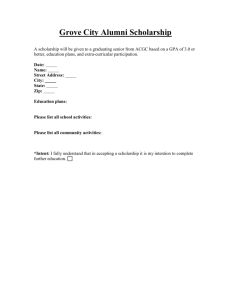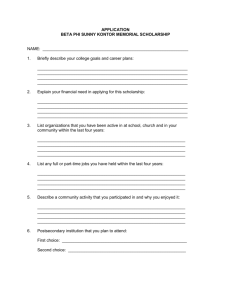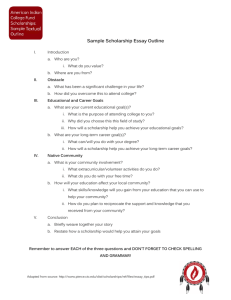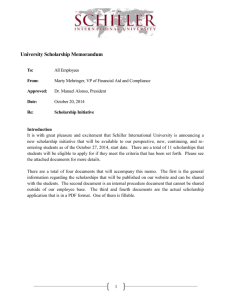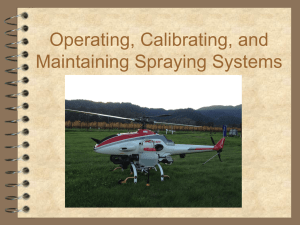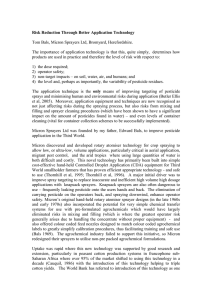The Scholarship of Extension
advertisement
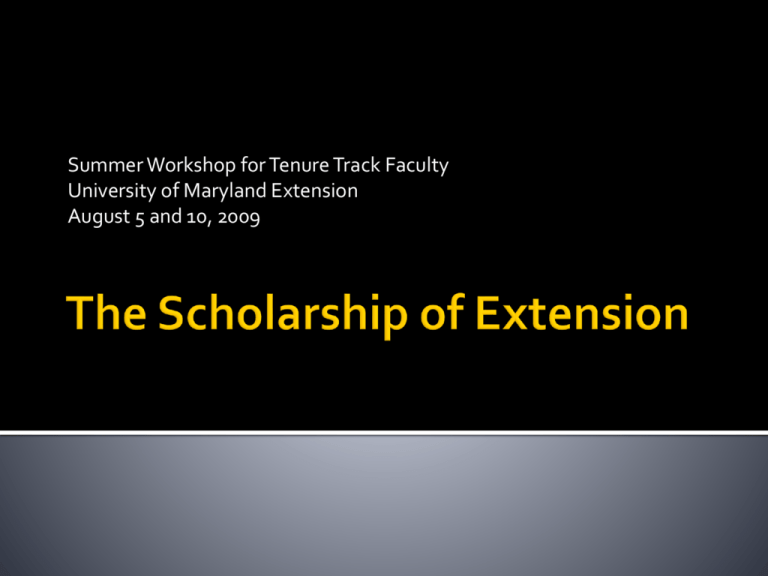
Summer Workshop for Tenure Track Faculty University of Maryland Extension August 5 and 10, 2009 “…scholarship and creative activity are understood to be intellectual work whose significance is communicated to and validated by peers.” Oregon State University Based on a high level of professional expertise Evidence of originality Documented and validated through peer review or critique Communicated in appropriate ways Impact on or significance for publics beyond the University or for the discipline. Discovery – Conducting research Integration – Giving meaning to knowledge and putting it into perspective Teaching – Enabling students to learn and participate more fully in society Application – Making knowledge useful Review the literature Set clear, realistic goals and measurable objectives. Keep abreast of the issues and determine resources needed. Choose appropriate methodology for project’s goals Document results. Scholarship is judged by its results. Communicate results with peers and others. Engage in reflective critique. Glassick, Huber, and Maeroff (1997) “Extension professionals already conduct a wide variety of applied and action research that exemplifies the goal of engaged scholarship. Where Extension often fails is systematically applying scientific tools and procedures to document and share the impact of their programs” (Davis, Burggraf-Torppa, Archer, Thomas, 2007). Significance Context Scholarship Impact Source: Points of Distinction: A Guide for Planning and Evaluation – Michigan Sate University To what extent were the project goals and objectives met? Did the products or deliverables meet the planning expectations? Were intended, unintended, and potential impacts documented and interpreted? Were stakeholders satisfied? Was there mutual satisfaction from the project? Did they value the results and apply the knowledge? Do impacts have commercial, societal, or professional value? How effectively are the products or results reaching the intended audience? To what extent did the project build capacity for individuals, institutions, or social infrastructure? To what extent did the project develop mechanisms for sustainability? How does the project lead to innovations in curriculum and inform other dimensions of the university mission? How did the project increase cross-disciplinary collaborations within the university or with other institutions? To what extent did the project leverage additional resources for any partners? A team of Extension professionals came together and developed a project to improve food safety education. The information distributed has since become the national standard for the safe handling and preparation of foods. The field crops agent started a pesticide sprayer tune-up program in which she and two other agents visited farms to help growers calibrate and check the operation of their sprayers. They were able to make improvements on 86% of the sprayers, thus saving growers' money from not wasting pesticide and from better pest control. Using data they collected on the pesticides used and the number of acres each sprayer was used for, they documented the dollar impact of the program. They developed a slide show on the sprayer tune-up procedure and how to correct the problems commonly found on sprayers, which was presented to larger statewide audiences. While the methods of calibrating and improving the operation of pesticide sprayers weren't new, the teaching methods used to encourage a large number of growers to change their practices were new. The program was then communicated to peers and validated, when the agent gave presentations and posters at both state and national levels. The Family Community Leadership program has continued to grow over the past five years due to one agent's efforts. She created a new volunteer model to manage the growing demand. She collected program statistics and teaching evaluations. She also developed a survey to measure the impact of the program on the volunteers and collected data that provided strong evidence of impact in the community. She plans to share the program and its impacts with other faculty through conferences and peer-reviewed publications. Keith Smith (2004) offers the following challenges to Extension professionals: Embrace evaluation more fully to show the impact of your work Share your work with colleagues through presentations and papers Partner with others across campus to share the Extension method of engagement (outreach) and to learn from others Shout about engagement (outreach) “Few if any issues are more important to the future of Extension than the issue of scholarship. It is essential that Extension educators strengthen their scholarship and scholarly practice if Extension is to continue as a viable provider of research-based, nonformal education in the twenty-first century” (Alter, 2003). JCEP Report on Extension Scholarship Della A. Baker State Program Leader for Evaluation, Accountability, and Staff Development Clemson University Cooperative Extension


